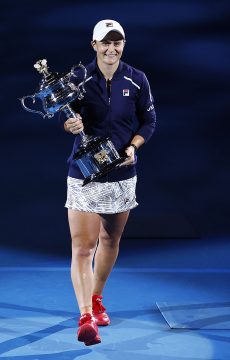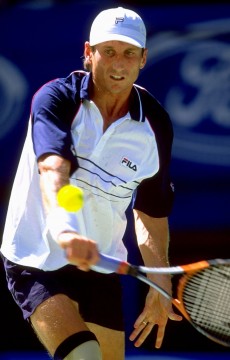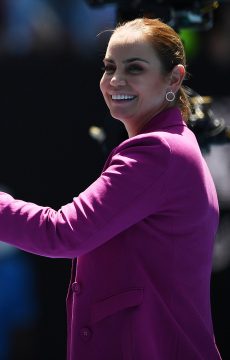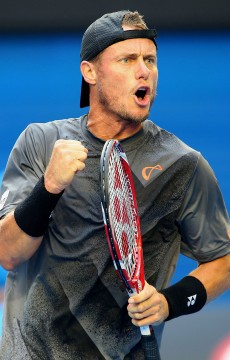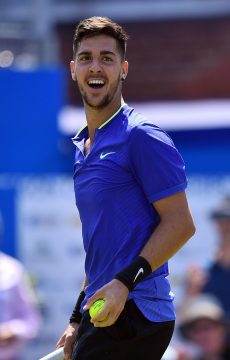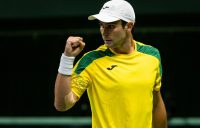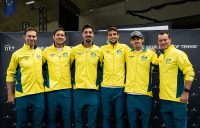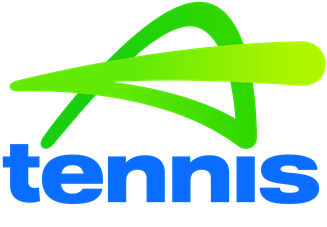Melbourne VIC, Australia, 26 August 2015 | Matt Trollope
One is a global individual sport, the other a domestic team game. Although tennis and Australian Rules football appear to be a case of “chalk and cheese” the two sports are becoming increasingly intertwined. MATT TROLLOPE reports.
With all the hours that elite tennis players spend grinding on the practice court, it’s crucial they keep their approach to training fresh. The best players in the world know this, and many incorporate cross-training methods into their preparation – Maria Sharapova frequently performs exercises with soccer and grid-iron balls, while Simona Halep likes to tear up the athletics track. Andy Murray champions the benefits of Bikram yoga.
Many of Australia’s tennis stars are turning to Australian Rules football. Recognising the example this sport can provide across several areas pertinent to tennis, several players have connected with AFL clubs and reaped the benefits.
It was recently announced that Thanasi Kokkinakis would begin working full time with Port Adelaide Football Club’s strength coach and performance nutritionist Andrew Rondinelli. The new arrangement is the extension of a professional relationship which blossomed when Kokkinakis spent two weeks in Dubai in late 2014 training with Port Adelaide.
> READ MORE: rising tennis star appoints Power strength and nutrition coach
In the time since then he has surged on the ATP World Tour; he has risen almost 80 places to crack the top 70, compiled a 33-15 win-loss record (through Cincinnati), and reached the fourth round at Indian Wells and third round at Roland Garros.
“They do a ridiculous amount of running,” Kokkinakis said of his footballing counterparts. “The movements are very different – theirs is more straight-line and tennis is a lot more lateral – but it’s always good to do some (straight-line) running, something I don’t really do much, to kind of build my engine and endurance a lot.
“I definitely think it paid off when it came to my first round in Australia (Kokkinakis saved four match points to beat No.11 seed Ernests Gulbis) … I’ve already started running a bit more (in training) and I’m going to continue to do so.
“It was just good for me to do something different. Get out of my comfort zone a little bit. I spend a lot of my time when I’m (in Australia) training here (in Melbourne) so I thought even though I travelled a lot last year it would be good to do something different to the other guys and just do my own thing and see how it goes.”
Kokkinakis’ connection with Port Adelaide came through Tyson Edwards, a former Adelaide Crows premiership player. Now the Power’s forward-line coach, Edwards became aware of Kokkinakis through his friendship with Lleyton Hewitt, and also happened to be friends with Kokkinakis’ coach Todd Langman. Around two years ago, Edwards approached Rondinelli, asking him to take the promising South Australian teen under his wing.
“Everything tennis-wise that was going on with (Thanasi) was absolutely perfect,” said Rondinelli. “(But) one thing that I noticed that was lacking both with Thanasi and across the tennis world was the whole sport science, recovery and nutrition area and I think AFL football, from a sports science point of view, we tend to be known for leading the way.”
Just as the idea was germinating to have Kokkinakis join the team for its most recent pre-season training camp in Dubai, Roger Federer was seeking a hitting partner – also in Dubai, and at the same time. Training with the 17-time Grand Slam champion became the focus of Kokkinakis’ trip, yet when he wasn’t working with Federer, he joined the Port players for weight training in the gym – following his own program – and took part in their recovery sessions and meal times. Said Rondinelli: “The main thing for me was to get him to start to see how our players prepare, they types of food they eat, how often they recover between sessions, and just seeing the workload that our guys do.”
After the Power returned to Australia, Rondinelli stayed in Dubai for four days and worked with Kokkinakis as he continued to train with Federer. “The big thing I noticed was a lot of the stuff Federer prided himself on was the stuff I was trying to get across to Thanasi,” Rondinelli said.
“The main thing I think he (came to understand) was the (importance of) recovery between sessions … The actual sessions he was doing with Roger were quite intense – he was hitting for three hours in the morning, having a bit of lunch, and then doing another three hours in the afternoon. And then he was doing the recovery things really well in that middle period over lunch. He was training as hard as our guys were, but in a tennis sense.”
Port Adelaide’s annual training camp has historically been exclusive to the team and conducted a long way from the eyes of media and fans; in its three-year history, Kokkinakis was the first athlete from another sport to attend. Yet he is not the only player who has been afforded the opportunity to link up with an AFL club.
Jelena Dokic worked closely with the Richmond Tigers’ former high performance manager Matt Hornsby in the 18 months preceding Australian Open 2009, where she stormed to the quarterfinals as a wildcard. A few years later, Ash Barty – a passionate Tigers supporter – began working with Hornsby over a two-year period.
Hornsby devised a program that focused on bolstering Barty’s on-court fitness. “Physical conditioning was one side (of her game) that she knew she had a lot of upside in,” he said. “We put a heat chamber (an enclosed space containing cardio equipment in which you can manipulate temperature and humidity) in at the footy club when we built the new facility (at Punt Road), and obviously with tennis following the sun, it’s quite a relevant training stimulus … It can be quite handy in that off-season period when the weather hasn’t quite warmed up to what you know you’re going to get when you play at the Brisbane International and obviously the Australian Open as well.”
With several Richmond players showing a keen interest in tennis, Barty was able to connect with many of them, most notably captain Trent Cotchin and Bachar Houli, who took her for some running sessions around Melbourne’s iconic “Tan” track. Some of the players also attended Barty’s matches at the Australian Open.
“I think she enjoyed the change in routine by being able to train down at the footy club,” Hornsby said.
Barty’s coach Jason Stoltenberg, a good friend of Hornsby’s, had seen an opportunity for his charge to build strong relationships with athletes outside the tennis sphere, especially given the young Queenslander’s love for Australian Rules football and sport in general.
“The club was nice enough to allow us to come to a couple of meetings, watch the guys train and get in the gym. For Ash at the time I found it was a healthy thing for her to do, to be able to talk to other elite athletes who might be dealing with some similar pressures and stresses and understanding how they go about their day, and their sport,” Stoltenberg said.
“The guys were great for Ash; they were excellent role models for her and were people who could sit with her and talk to her about sport, and life … being able to connect and communicate with these people who she looked up to was important to her and gave her a lot of confidence. She found it really interesting talking to them, listening to their stories and watching them train.
“I think if you can create some relationships outside tennis, it just allows (players) to create a bit more balance in their own life and not just be tennis, tennis, tennis all the time.”
Tennis Australia’s physical performance manager Aaron Kellett sees multiple benefits in the nation’s best tennis players connecting with football clubs, and elite athletes in other sporting fields.
From a physical perspective, there needs to be a strategic approach behind it; while the preparation for any sport’s competitive season begins quite generally in nature – there is crossover in much of the cardio training and recovery work, meaning athletes of different disciplines can often train together – it quickly becomes more specific to each sport as competition dates draw closer.
Yet from a professional development standpoint, there is an incredible amount to gain. Kellett says that while he doesn’t think we will see a significant increase in the number of tennis players following Kokkinakis’ and Barty’s lead, such arrangements will continue to occur. “That ‘cross-pollination’ (of athletes) is already happening without people necessarily being aware of it,” he said.
“The capacity to have players from, say, Hawthorn footy club come in and speak to our guys, or have Nick Kyrgios to go and spend a day with (Hawthorn’s consulting sports psychologist) Anthony Klarica just meeting some of the Hawthorn guys and being in and round their environment, this has happened without any fanfare because that’s just what we do.
“Those sort of networking opportunities, we actually encourage our staff (to pursue them) and we lean on those ourselves. Because for the same sort of benefits that the athlete may get in and around their professional behaviours, we also get that.
“The Australian sporting landscape is littered with these sorts of collaborative, networking kind of relationships, and that benefits everyone.”
You can read the full feature – including more insights and interviews with other players – in the June issue of Australian Tennis Magazine. Subscribe now!



